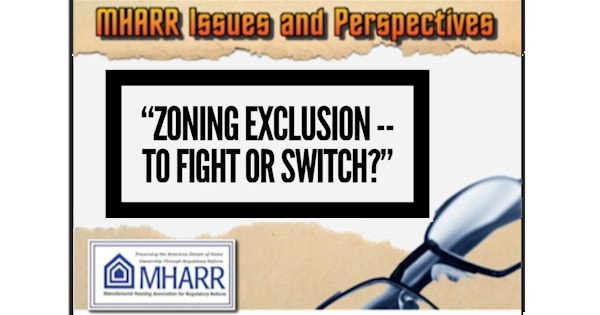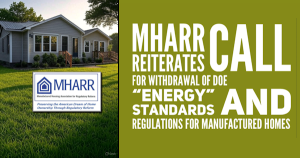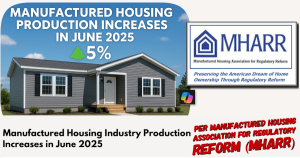“Zoning Exclusion — To Fight Or Switch?”

For those of us “senior” enough to remember cigarette commercials on television, an iconic brand, with a somewhat unusual advertising approach, was Tareyton cigarettes. Tareyton commercials featured “smokers” with phony black eyes, who supposedly preferred to “fight” rather than “switch” to some other cigarette brand. The idea, of course, was to promote brand loyalty. Unfortunately, though, when it comes to the manufactured housing industry’s most pressing and economically damaging problems – exclusionary zoning mandates and discriminatory limitations on consumer financing support for the vast bulk of the mainstream HUD Code market — it appears that some, instead of “fighting” for full acceptance of the industry’s mainstream homes, might prefer to “switch” to something outside of that affordable mainstream.
Few would dispute that for almost its entire history, the mainstream manufactured housing industry has faced significant challenges to its advancement and growth. Over time, these challenges have affected aspects of bothprincipal segments of the industry – its production segment and its post-production segment. Fortunately, within the production sector, MHARR, since its establishment as an independent trade organization in 1985, has been able to advance fair and reasonable federal regulation, capped-off by the enactment of the Manufactured Housing Improvement Act in 2000, which established and, in other cases, strengthened key regulatory protections for manufactured housing producers and consumers.
Unfortunately, the same cannot be said for the industry’s post-production sector. Within that sector, the Manufactured Housing Institute (MHI) — by subsuming the former National Manufactured Housing Federation (in 1991) and thereby ending any independent national representation for that sector and especially its smaller businesses — assumed and became solely responsible for the representation and advancement of post-production interests in the nation’s capital. Yet – or arguably because of the lack of aggressive, independent national post-production representation after 1991 — it is squarely within the post-production sector that the industry’s most serious problems, as noted above (i.e., lack of consumer financing and zoning equity), remain and continue to act as major roadblocks to the fulfillment of manufactured housing’s true and complete potential for Americans in need of affordable housing.
It cannot be overemphasized that the financing and zoning problems affecting the mainstream HUD Code post-production sector are not attributable to the quality or safety of the industry’s modern-day homes. The industry today – and for the entire twenty years following the enactment of the 2000 reform law – has been producing (and continues to produce) its best homes ever. These mainstream HUD Code homes not only offer homebuyers every amenity available in a modern high-quality home, but they do so at a price point that is inherently affordable for every American at every (and any) income level.
To the contrary, the zoning and financing limitations that have restricted the growth of the mainstream manufactured housing market and have unconscionably limited the housing choices of moderate and lower-income Americans, are fundamentally discriminatory in nature – i.e., they are not based on current-day provable facts relating to mainstream federally-regulated manufactured homes, but rather are an artificial, exaggerated relic of an earlier time and earlier prejudices that the product itself has long since outgrown. Put differently, these prejudices, like all others, are a product of groundless fear and ignorance divorced from the reality of the modern-day product and the modern-day mainstream manufactured housing market.
As such, these baseless, outdated prejudices could and should have been addressed and overcome over the course of time – and the past two decades, especially. Certainly, the tools to address these issues have been available for that entire time, as MHARR has repeatedly observed and emphasized. With respect to zoning discrimination Congress, in the 2000 reform law, strengthened and enhanced federal preemption in order allow for the invalidation of state or local “requirements,” such as discriminatory zoning mandates, that have the effect of excluding mainstream manufactured homes. And lest there be any doubt about what this enhanced preemption means and what it was designed to do, leading members of Congress in a November 2003 letter to HUD made it quite clear, stating that the 2000 changes to the federal manufactured housing law give HUD “the legal authority to preempt local requirements or restrictions which discriminate against the siting of manufactured homes (compared to other single-family housing) simply because they are HUD Code homes.”
Similarly, with respect to consumer financing, MHARR and MHI, working together, were able to secure congressional adoption of the “Duty to Serve” (DTS) mandate as a specific remedy for years of discrimination against manufactured home consumer loans by both Fannie Mae and Freddie Mac.
With these strong mandates at the disposal of the national representation for the industry’s post-production sector, significant progress (or at least some progress) should have been possible on both of these issues over time, with a persistent, aggressive, and unapologetic approach to both. Of course, though, the reality is, has been, and continues to be, quite different. For twenty years, HUD has faced little or no real pressure from MHI to implement the enhanced federal preemption of the 2000 reform law as a means to invalidate discriminatory local zoning mandates that either exclude or unreasonably restrict the placement of mainstream HUD Code manufactured homes. Meanwhile, both Fannie Mae and Freddie Mac – and their federal regulator, the Federal Housing Finance Agency (FHFA) — have been consistently praised by MHI, despite having done absolutely nothing, over the course of more than a decade since the adoption of DTS, to provide any type of market support for the personal property (i.e., chattel) loans that constitute nearly 80 percent of the mainstream manufactured housing consumer financing market. Again, all the while, consumers have suffered, while industry production has remained consistently below historical benchmarks.
Against this backdrop, and to make matters even worse, there seems to be a “new” approach by MHI to both of these endemic problems. Rather than “fight” for the acceptance of mainstream, affordable manufactured homes, which would be best for the industry as a whole and for the vast majority of actual manufactured housing consumers, MHI, seemingly following the lead of its largest manufacturers, appears to have “switched” to pushing for much more costly hybrid or “boutique” type homes, as exemplified by its ostensibly proprietary “CrossMod” designation.
After doing precious little for twenty years, then, to advance the concept of enhanced federal preemption as a bar to discriminatory local zoning mandates against mainstream HUD Code homes, or otherwise vigorously pursue challenges to blatantly discriminatory zoning restrictions against manufactured housing (and manufactured homeowners), MHI has seemingly settled on a two-track approach to these destructive edicts. First acknowledge, finally, that the problem exists as a problem while, second, undertaking a somewhat less pronounced effort to sidestep the “problem” entirely by promoting the production, sale, use and securitization (under DTS) of boutique hybrids that are out of the manufactured housing market mainstream, are not affordable for many current-day manufactured housing consumers, and are almost exclusively the province of the industry’s largest corporate conglomerates, because their cost makes them impractical for most of the industry and most of the industry’s lower and moderate-income consumers.
The “public acknowledgment” side of this effort is exemplified by a June 2020 MHInsider interview with MHI Board of Directors member, Cody Pearce. In that interview, Mr. Pearce states in part: “[W]e, as an industry, need to find a way to solve the zoning issues that prevent … HUD [Code] homes from going into most municipalities. It’s a real issue that MHI and their membership will be taking on. *** [S]imply improving the financing markets is not enough. The lean chattel market is really a reflection of zoning constraints and a misplaced stigma around the sector.” (Emphasis added).
Will be taking on? When? The discriminatory and exclusionary zoning problem that the industry faces today has been around – and has been a problem – for decades. MHARR, for its part, has been actively fighting this battle for years, even though it does not collect representation dues from the post-production sector. But MHI is just getting around to publicly acknowledging the problem and the need to confront it in an organized and consistent manner – sometime in the future … maybe? More to the point, while it is comforting to know that MHI — prospectively at least — plans to begin “taking on” the problem of discriminatory zoning and placement, which has been a drag on the national manufactured housing market for decades, that “plan” – more than twenty years after the enactment of the enhanced preemption provision of the 2000 reform law — has not been matched by any significant public action to change the sorry and destructive status quo.
Instead, it appears that far more effort is being put into the somewhat less-open second prong of this approach — promoting especially favorable DTS treatment for boutique hybrid homes, such as “Cross-Mod,” as a means of bypassing or sidestepping discriminatory zoning that excludes mainstream, affordable manufactured homes. Thus, in October 16, 2020 comments offered at an FHFA DTS “listening session,” MHI Chief Executive Officer Lesli Gooch stated: “CrossMod homes are a point of entry for home buyers who are currently priced out of homeownership because traditional site-built housing is not produced at below $200,000. *** These homes have the potential to reach areas of the country where manufactured housing has, in the past, been zoned out by discriminatory land use regulations at the state and local level.” (Emphasis added).
So, while MHI officials publicly state that it is prepared, at some point, to fight discriminatory and exclusionary zoning targeting mainstream, affordable, HUD Code manufactured homes — the type that is a true source of affordable housing and homeownership for all Americans — it is simultaneously leading the charge, using DTS as a “wedge,” to switch to proprietary hybrids (i.e., something other than mainstream, affordable manufactured housing) produced by the industry’s largest corporate conglomerates, as a means to sidestep and avoid the same discriminatory zoning restrictions and exclusions that it allegedly plans to “take on” — sometime. This would appear to be the polar opposite of the Tareyton folks – i.e., switching to something other than mainstream manufactured homes, rather than “fighting” anytime soon on behalf of mainstream manufactured homes and mainstream manufactured homebuyers.
Arguably, then, this “two-track” approach is little more than double-talk – i.e., say one thing publicly and then do another where it is less likely to be noticed and less likely to be called-out and exposed for what it is — which provides regulators at HUD and FHFA (as well as Fannie Mae and Freddie Mac) with a ready and convenient excuse to continue evading and circumventing the good laws that Congress has provided for the benefit of mainstream manufactured housing and mainstream manufactured housing consumers. This runs directly counter to the responsibility and obligation to protect, defend and advance the industry’s post-production sector, that MHI assumed in 1991 when it merged with National Manufactured Housing Federation.
MHARR, for its part does not – and will not — support changing the essential nature and inherent affordability of HUD Code manufactured housing. Instead, it supports properly using the law that is currently on the books in order to achieve the objectives and purposes they were designed to advance. In other words, MHARR would rather “fight” (figuratively) than switch. Advocating for what is right is more difficult than just switching to something else that is more in line with the preferences of the industry’s detractors and opponents. Ultimately, though, aggressive advocacy for mainstream, affordable manufactured housing will be far more beneficial for both consumers and the industry as a whole.
Mark Weiss
MHARR is a Washington, D.C.-based national trade association representing the views and interests of independent producers of federally-regulated manufactured housing.
“MHARR-Issues and Perspectives” is available for re-publication in full (i.e., without alteration or substantive modification) without further permission and with proper attribution to MHARR.

For those of us “senior” enough to remember cigarette commercials on television, an iconic brand, with a somewhat unusual advertising approach, was Tareyton cigarettes. Tareyton commercials featured “smokers” with phony black eyes, who supposedly preferred to “fight” rather than “switch” to some other cigarette brand. The idea, of course, was to promote brand loyalty. Unfortunately, though, when it comes to the manufactured housing industry’s most pressing and economically damaging problems – exclusionary zoning mandates and discriminatory limitations on consumer financing support for the vast bulk of the mainstream HUD Code market — it appears that some, instead of “fighting” for full acceptance of the industry’s mainstream homes, might prefer to “switch” to something outside of that affordable mainstream.
Few would dispute that for almost its entire history, the mainstream manufactured housing industry has faced significant challenges to its advancement and growth. Over time, these challenges have affected aspects of bothprincipal segments of the industry – its production segment and its post-production segment. Fortunately, within the production sector, MHARR, since its establishment as an independent trade organization in 1985, has been able to advance fair and reasonable federal regulation, capped-off by the enactment of the Manufactured Housing Improvement Act in 2000, which established and, in other cases, strengthened key regulatory protections for manufactured housing producers and consumers.
Unfortunately, the same cannot be said for the industry’s post-production sector. Within that sector, the Manufactured Housing Institute (MHI) — by subsuming the former National Manufactured Housing Federation (in 1991) and thereby ending any independent national representation for that sector and especially its smaller businesses — assumed and became solely responsible for the representation and advancement of post-production interests in the nation’s capital. Yet – or arguably because of the lack of aggressive, independent national post-production representation after 1991 — it is squarely within the post-production sector that the industry’s most serious problems, as noted above (i.e., lack of consumer financing and zoning equity), remain and continue to act as major roadblocks to the fulfillment of manufactured housing’s true and complete potential for Americans in need of affordable housing.
It cannot be overemphasized that the financing and zoning problems affecting the mainstream HUD Code post-production sector are not attributable to the quality or safety of the industry’s modern-day homes. The industry today – and for the entire twenty years following the enactment of the 2000 reform law – has been producing (and continues to produce) its best homes ever. These mainstream HUD Code homes not only offer homebuyers every amenity available in a modern high-quality home, but they do so at a price point that is inherently affordable for every American at every (and any) income level.
To the contrary, the zoning and financing limitations that have restricted the growth of the mainstream manufactured housing market and have unconscionably limited the housing choices of moderate and lower-income Americans, are fundamentally discriminatory in nature – i.e., they are not based on current-day provable facts relating to mainstream federally-regulated manufactured homes, but rather are an artificial, exaggerated relic of an earlier time and earlier prejudices that the product itself has long since outgrown. Put differently, these prejudices, like all others, are a product of groundless fear and ignorance divorced from the reality of the modern-day product and the modern-day mainstream manufactured housing market.
As such, these baseless, outdated prejudices could and should have been addressed and overcome over the course of time – and the past two decades, especially. Certainly, the tools to address these issues have been available for that entire time, as MHARR has repeatedly observed and emphasized. With respect to zoning discrimination Congress, in the 2000 reform law, strengthened and enhanced federal preemption in order allow for the invalidation of state or local “requirements,” such as discriminatory zoning mandates, that have the effect of excluding mainstream manufactured homes. And lest there be any doubt about what this enhanced preemption means and what it was designed to do, leading members of Congress in a November 2003 letter to HUD made it quite clear, stating that the 2000 changes to the federal manufactured housing law give HUD “the legal authority to preempt local requirements or restrictions which discriminate against the siting of manufactured homes (compared to other single-family housing) simply because they are HUD Code homes.”
Similarly, with respect to consumer financing, MHARR and MHI, working together, were able to secure congressional adoption of the “Duty to Serve” (DTS) mandate as a specific remedy for years of discrimination against manufactured home consumer loans by both Fannie Mae and Freddie Mac.
With these strong mandates at the disposal of the national representation for the industry’s post-production sector, significant progress (or at least some progress) should have been possible on both of these issues over time, with a persistent, aggressive, and unapologetic approach to both. Of course, though, the reality is, has been, and continues to be, quite different. For twenty years, HUD has faced little or no real pressure from MHI to implement the enhanced federal preemption of the 2000 reform law as a means to invalidate discriminatory local zoning mandates that either exclude or unreasonably restrict the placement of mainstream HUD Code manufactured homes. Meanwhile, both Fannie Mae and Freddie Mac – and their federal regulator, the Federal Housing Finance Agency (FHFA) — have been consistently praised by MHI, despite having done absolutely nothing, over the course of more than a decade since the adoption of DTS, to provide any type of market support for the personal property (i.e., chattel) loans that constitute nearly 80 percent of the mainstream manufactured housing consumer financing market. Again, all the while, consumers have suffered, while industry production has remained consistently below historical benchmarks.
Against this backdrop, and to make matters even worse, there seems to be a “new” approach by MHI to both of these endemic problems. Rather than “fight” for the acceptance of mainstream, affordable manufactured homes, which would be best for the industry as a whole and for the vast majority of actual manufactured housing consumers, MHI, seemingly following the lead of its largest manufacturers, appears to have “switched” to pushing for much more costly hybrid or “boutique” type homes, as exemplified by its ostensibly proprietary “CrossMod” designation.
After doing precious little for twenty years, then, to advance the concept of enhanced federal preemption as a bar to discriminatory local zoning mandates against mainstream HUD Code homes, or otherwise vigorously pursue challenges to blatantly discriminatory zoning restrictions against manufactured housing (and manufactured homeowners), MHI has seemingly settled on a two-track approach to these destructive edicts. First acknowledge, finally, that the problem exists as a problem while, second, undertaking a somewhat less pronounced effort to sidestep the “problem” entirely by promoting the production, sale, use and securitization (under DTS) of boutique hybrids that are out of the manufactured housing market mainstream, are not affordable for many current-day manufactured housing consumers, and are almost exclusively the province of the industry’s largest corporate conglomerates, because their cost makes them impractical for most of the industry and most of the industry’s lower and moderate-income consumers.
The “public acknowledgment” side of this effort is exemplified by a June 2020 MHInsider interview with MHI Board of Directors member, Cody Pearce. In that interview, Mr. Pearce states in part: “[W]e, as an industry, need to find a way to solve the zoning issues that prevent … HUD [Code] homes from going into most municipalities. It’s a real issue that MHI and their membership will be taking on. *** [S]imply improving the financing markets is not enough. The lean chattel market is really a reflection of zoning constraints and a misplaced stigma around the sector.” (Emphasis added).
Will be taking on? When? The discriminatory and exclusionary zoning problem that the industry faces today has been around – and has been a problem – for decades. MHARR, for its part, has been actively fighting this battle for years, even though it does not collect representation dues from the post-production sector. But MHI is just getting around to publicly acknowledging the problem and the need to confront it in an organized and consistent manner – sometime in the future … maybe? More to the point, while it is comforting to know that MHI — prospectively at least — plans to begin “taking on” the problem of discriminatory zoning and placement, which has been a drag on the national manufactured housing market for decades, that “plan” – more than twenty years after the enactment of the enhanced preemption provision of the 2000 reform law — has not been matched by any significant public action to change the sorry and destructive status quo.
Instead, it appears that far more effort is being put into the somewhat less-open second prong of this approach — promoting especially favorable DTS treatment for boutique hybrid homes, such as “Cross-Mod,” as a means of bypassing or sidestepping discriminatory zoning that excludes mainstream, affordable manufactured homes. Thus, in October 16, 2020 comments offered at an FHFA DTS “listening session,” MHI Chief Executive Officer Lesli Gooch stated: “CrossMod homes are a point of entry for home buyers who are currently priced out of homeownership because traditional site-built housing is not produced at below $200,000. *** These homes have the potential to reach areas of the country where manufactured housing has, in the past, been zoned out by discriminatory land use regulations at the state and local level.” (Emphasis added).
So, while MHI officials publicly state that it is prepared, at some point, to fight discriminatory and exclusionary zoning targeting mainstream, affordable, HUD Code manufactured homes — the type that is a true source of affordable housing and homeownership for all Americans — it is simultaneously leading the charge, using DTS as a “wedge,” to switch to proprietary hybrids (i.e., something other than mainstream, affordable manufactured housing) produced by the industry’s largest corporate conglomerates, as a means to sidestep and avoid the same discriminatory zoning restrictions and exclusions that it allegedly plans to “take on” — sometime. This would appear to be the polar opposite of the Tareyton folks – i.e., switching to something other than mainstream manufactured homes, rather than “fighting” anytime soon on behalf of mainstream manufactured homes and mainstream manufactured homebuyers.
Arguably, then, this “two-track” approach is little more than double-talk – i.e., say one thing publicly and then do another where it is less likely to be noticed and less likely to be called-out and exposed for what it is — which provides regulators at HUD and FHFA (as well as Fannie Mae and Freddie Mac) with a ready and convenient excuse to continue evading and circumventing the good laws that Congress has provided for the benefit of mainstream manufactured housing and mainstream manufactured housing consumers. This runs directly counter to the responsibility and obligation to protect, defend and advance the industry’s post-production sector, that MHI assumed in 1991 when it merged with National Manufactured Housing Federation.
MHARR, for its part does not – and will not — support changing the essential nature and inherent affordability of HUD Code manufactured housing. Instead, it supports properly using the law that is currently on the books in order to achieve the objectives and purposes they were designed to advance. In other words, MHARR would rather “fight” (figuratively) than switch. Advocating for what is right is more difficult than just switching to something else that is more in line with the preferences of the industry’s detractors and opponents. Ultimately, though, aggressive advocacy for mainstream, affordable manufactured housing will be far more beneficial for both consumers and the industry as a whole.
Mark Weiss
MHARR is a Washington, D.C.-based national trade association representing the views and interests of independent producers of federally-regulated manufactured housing.
“MHARR-Issues and Perspectives” is available for re-publication in full (i.e., without alteration or substantive modification) without further permission and with proper attribution to MHARR.













